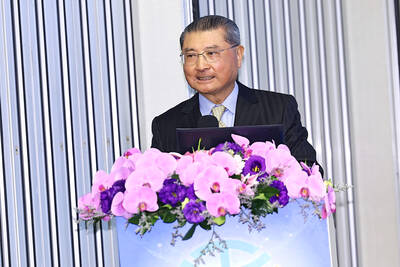The yen hovered near a five-month low against the dollar yesterday, as the US Federal Reserve’s hawkish messaging contrasted with the Bank of Japan’s (BOJ) cautious approach to further policy tightening.
The yen traded at 157.765 per US dollar as of 6am GMT, edging up 0.1 percent from Thursday, but still close to that session’s low of 158.09 per dollar, the yen’s weakest level since July 17.
Japan’s currency got little respite from a fresh warning by the country’s minister of finance that the government “has been alarmed by foreign exchange developments ... and will take appropriate action against excessive moves.”

Photo: AFP
A summary of opinions from the BOJ’s December policy meeting released yesterday showed some officials becoming more confident about a near-term rate increase, while others remained wary amid uncertainties over the trend of wages and the policies of US president-elect Donald Trump’s incoming administration.
After the central bank’s decision last week to hold rates steady, BOJ Governor Kazuo Ueda said that it would take “considerable time” to fully gauge the outlooks for wages and overseas economies, particularly the US.
By contrast, US Fed Chair Jerome Powell earlier this month said that US central bank officials “are going to be cautious about further cuts” following an expected quarter-point rate reduction.
Trump’s proposed looser regulation, tax cuts, tariff hikes and tighter immigration policies are seen as pro-growth and inflationary by economists.
The dollar is on track for a 5.5 percent gain this month against the yen, and an 11.8 percent advance for the year.
“The upward trend is strong, but there’s a feeling that the strong dollar-weak yen movement we’ve seen to now is overdone and there’s the risk of pullbacks,” Mizuho Securities analysts Masafumi Yamamoto and Masayoshi Mihara wrote in a client note.
“There’s also the possibility of firmer intervention warnings from Japanese officials,” they said.
The US dollar index, which measures the currency against the yen, euro, sterling and three other major rivals, ticked up 0.08 percent to 108.16. It has been essentially in a holding pattern near 108 all week, with many traders on holiday around Christmas and the New Year.
The index is up 2.2 percent for the month. It has rallied 6.7 percent so far this year.
The euro eased 0.13 percent to US$1.04085, heading for a 1.6 percent decline this month. The UK pound edged down 0.07 percent to US$1.2519 on the day, on track for a 1.7 percent slide for the month.
South Korea’s won dropped to a fresh 16-year-low of 1,486.7 per dollar, with the country’s acting president facing an impeachment vote.
The Chinese yuan was set to end the week near a 13-month low against the dollar, trading at 7.2988 per dollar in the onshore market, right on the cusp of the closely watched 7.3 level. The currency has suffered under the threat of additional US tariffs on Chinese goods under Trump.
Leading cryptocurrency bitcoin added 0.5 percent for the month to US$96,165, down from a record high of US$108,379.28 on Tuesday last week. It has surged about 126 percent so far this year.

When an apartment comes up for rent in Germany’s big cities, hundreds of prospective tenants often queue down the street to view it, but the acute shortage of affordable housing is getting scant attention ahead of today’s snap general election. “Housing is one of the main problems for people, but nobody talks about it, nobody takes it seriously,” said Andreas Ibel, president of Build Europe, an association representing housing developers. Migration and the sluggish economy top the list of voters’ concerns, but analysts say housing policy fails to break through as returns on investment take time to register, making the

‘SILVER LINING’: Although the news caused TSMC to fall on the local market, an analyst said that as tariffs are not set to go into effect until April, there is still time for negotiations US President Donald Trump on Tuesday said that he would likely impose tariffs on semiconductor, automobile and pharmaceutical imports of about 25 percent, with an announcement coming as soon as April 2 in a move that would represent a dramatic widening of the US leader’s trade war. “I probably will tell you that on April 2, but it’ll be in the neighborhood of 25 percent,” Trump told reporters at his Mar-a-Lago club when asked about his plan for auto tariffs. Asked about similar levies on pharmaceutical drugs and semiconductors, the president said that “it’ll be 25 percent and higher, and it’ll

CHIP BOOM: Revenue for the semiconductor industry is set to reach US$1 trillion by 2032, opening up opportunities for the chip pacakging and testing company, it said ASE Technology Holding Co (日月光投控), the world’s largest provider of outsourced semiconductor assembly and test (OSAT) services, yesterday launched a new advanced manufacturing facility in Penang, Malaysia, aiming to meet growing demand for emerging technologies such as generative artificial intelligence (AI) applications. The US$300 million facility is a critical step in expanding ASE’s global footprint, offering an alternative for customers from the US, Europe, Japan, South Korea and China to assemble and test chips outside of Taiwan amid efforts to diversify supply chains. The plant, the company’s fifth in Malaysia, is part of a strategic expansion plan that would more than triple

Taiwanese artificial intelligence (AI) server makers are expected to make major investments in Texas in May after US President Donald Trump’s first 100 days in office and amid his rising tariff threats, Taiwan Electrical and Electronic Manufacturers’ Association (TEEMA, 台灣電子電機公會) chairman Richard Lee (李詩欽) said yesterday. The association led a delegation of seven AI server manufacturers to Washington, as well as the US states of California, Texas and New Mexico, to discuss land and tax issues, as Taiwanese firms speed up their production plans in the US with many of them seeing Texas as their top option for investment, Lee said. The